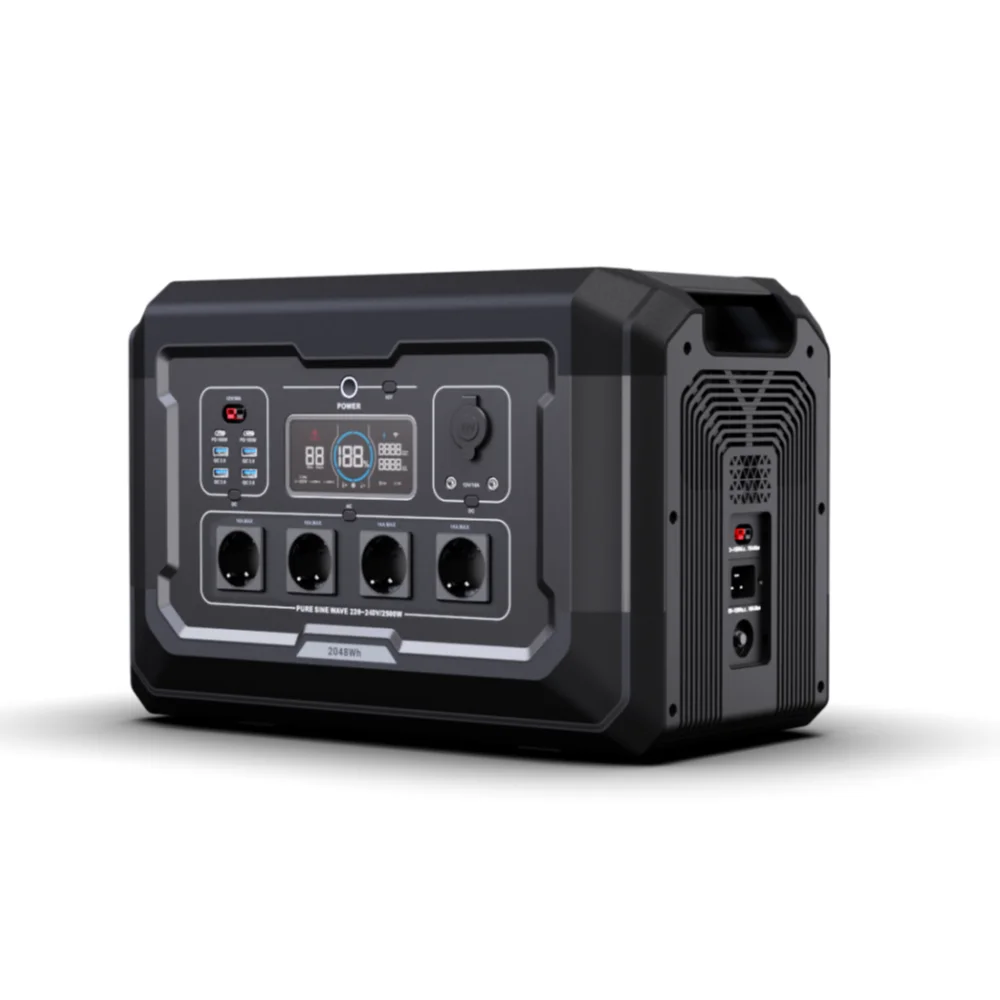How about the charging efficiency of solar generators for laptops? Let's measure!
Understanding Solar Generator Efficiency Basics
How Solar Charging Works for Laptops
Solar charging is a fascinating process that transforms abundant sunlight into usable electricity through solar panels. These panels consist of photovoltaic cells that capture solar energy, converting it into direct current (DC) electricity. This electricity is then stored in batteries, providing a reserve that can be utilized to power various devices, including laptops. To make this stored DC electricity compatible for laptops, inverter systems play a crucial role by converting it to alternating current (AC) with the necessary voltage and frequency the laptops require.
In practical scenarios, a typical solar charging setup for laptops involves connecting solar panels to a charge controller, which manages the flow of electricity to prevent battery damage. This is often accompanied by an inverter to ensure the correct AC output for charging the laptop. For instance, Sunbolt provides solar workstations designed for charging laptops outdoors, integrating innovative technology with practicality to enable seamless use in diverse settings.
Watt-Hour Capacity vs. Device Requirements
Watt-hour (Wh) capacity is a fundamental measure of energy storage potential and is directly tied to how long a device, like a laptop, can be powered. It is crucial to understand the power requirements of different laptop models, which can vary significantly. For example, smaller laptops such as Chromebooks typically require between 45-65 watts to charge, whereas larger gaming laptops may exceed 90 watts due to higher energy needs.
The power output of a solar generator is pivotal in determining how swiftly a laptop can be charged. A generator with a higher watt-hour capacity will charge devices faster, meeting their power requirements effectively. To illustrate, a 300Wh solar generator can supplement the power needs of a standard laptop, which usually requires around 45W, for a few hours, ensuring uninterrupted usage during power outages. By comparing watt-hour capacity with device power needs, one can effectively plan energy consumption and optimize performance.
Key Factors Impacting Charging Performance
Solar Panel Wattage & Conversion Rates
Higher wattage solar panels can significantly speed up charging times. The wattage of a solar panel refers to its power output capacity, and generally, panels with higher wattage produce more electricity under optimal conditions. For instance, a 200-watt solar panel might generate more energy than a 100-watt panel, enabling faster recharging of devices. However, conversion efficiency rates also play a crucial role in energy capture. Conversion efficiency is the percentage of sunlight converted into usable electricity. According to research, modern solar panels generally have conversion efficiencies ranging from 15% to 25%, depending on conditions like cloud cover and sunlight intensity. Moreover, factors like panel orientation and placement greatly influence solar energy capture. Ideally, panels should be oriented to face maximum sunlight throughout the day, often requiring adjustments based on seasonal changes or geographical location.
Battery Storage Capacity Considerations
Choosing the right battery capacity is pivotal for optimal charging times in solar generators. Different types of batteries are used, such as lithium-ion and lead-acid, each with unique properties. Lithium-ion batteries are popular for their long lifespan and efficient energy storage, while lead-acid batteries might be bulky but offer lower initial costs. The battery discharge rate further affects the duration for which a laptop can be charged. For example, a lithium-ion battery might discharge at a consistent rate, preserving laptop power longer compared to other battery types. Statistics indicate that lithium-ion batteries may last up to 4,000 cycles before degrading to 70% capacity, making them a preferred choice for prolonged generator use under varying loads.
Sunlight Exposure & Weather Dependencies
Direct sunlight markedly improves the efficiency of solar panels and chargers. Panels exposed to unobstructed sunlight generate more electricity than when under cloud cover or shade. Weather conditions, such as overcast skies or rain, can adversely affect solar generator performance by reducing sunlight exposure. This is evident in data showing a notable variance in solar energy production across regions and seasons, like higher electricity output during sunny summer months compared to cloudy winters. Monitoring sunlight exposure is critical to maximizing charging potential and ensuring consistent energy availability. Solar generators equipped with tracking systems to optimize sunlight capture can enhance performance significantly, adapting to changing weather conditions and maximizing energy output all year.
Calculating Laptop Charging Times with Solar
Formula for Estimating Charge Duration
To calculate how long it will take to charge a laptop with a solar generator, follow this step-by-step formula. First, understand the key variables involved: the battery size of your laptop (in watts per hour), the solar generator output (also in watts), and the laptop's power consumption rate (watts used per hour). Given these inputs, you can estimate the charging time using the formula:
- Determine the laptop's battery capacity: For example, a laptop with a 50Wh battery capacity requires 50 watt-hours to charge fully.
- Identify the solar generator power output: Suppose your solar generator produces 100W.
- Estimate power consumption: Calculate the laptop's hourly power draw, such as 20W.
With these inputs, the formula becomes:
Charging Time = Laptop Battery Capacity / (Solar Generator Power Output - Laptop Power Consumption)
For our example, the charging time is:
50 Wh / (100 W - 20 W) = 50 Wh / 80 W = 0.625 hours
For convenience, consider using calculator tools or apps that provide real-time calculations. These tools often account for fluctuations in solar output, ensuring that adjustments for varying sunlight conditions yield accurate estimations.
Real-World Efficiency Adjustments
When estimating solar-powered charging times, real-world efficiency adjustments are crucial. Factors such as energy loss during conversion often alter theoretical outcomes. For instance, solar generators may lose some energy due to inefficiencies in conversion from solar DC to appliance-compatible AC power. Understanding these efficiency losses helps in setting realistic expectations.
User experiences can provide valuable insights into performance disparities. One solar generator user found that while theoretical calculations predicted optimal charging times, actual scenarios varied due to fluctuating sunlight and conversion inefficiencies. Tips for practical adjustments include testing your setup under various conditions to gauge real-world output. Consider using tools to monitor energy loss patterns and adjust your solar panel angles to optimize sunlight capture. These insights can refine your expectations, ensuring accurate estimates of charging capabilities.
Top Solar Generators Optimized for Laptop Use
2048WH Outdoor Solar Generator: Portable 2500W System
The 2048WH Outdoor Solar Generator offers a powerful and portable solution for powering devices, including laptops, especially suited for outdoor environments. With a capacity of 2500W, this generator is designed to handle energy-intensive tasks and ensures longevity in laptop charging during off-grid scenarios. Its portability makes it an ideal choice for camping trips or any outdoor activities where reliable power is essential. Comparing its efficiency and output to other models, this generator stands out for its robust performance. Users have shared positive testimonials, highlighting its ease of use and reliability in real-world applications. This generator's all-around efficiency and user-friendly design make it a top pick for anyone needing portable power for laptops.
Deye 10kW Hybrid Inverter: Pure Sine Wave Precision
The Deye 10kW Hybrid Inverter incorporates Pure Sine Wave Technology, essential for delivering stable and consistent power, safeguarding laptops and other sensitive devices. This inverter is an excellent choice for maximizing solar energy utilization while ensuring a seamless interplay between grid power and battery use. It not only aids in efficient charging but elevates the reliability of your devices by offering uninterrupted power supply options. When assessed against competitors, this inverter shines due to its precise power delivery and hybrid capabilities. Feedback from users underscores its efficiency, highlighting its pivotal role in maintaining consistent device performance even under variable solar conditions.
Deye 5kW-12kW LV Inverters: Scalable Energy Solutions
The Deye 5kW-12kW LV Inverters present scalable energy solutions that cater to growing energy demands, making them ideal for both residential and commercial applications. These inverters are designed to handle multiple devices simultaneously, including laptops, by integrating solar power with battery storage efficiently. Their scalability offers a significant advantage over fixed capacity systems, enabling users to expand their setups as needed. Technical features like multiple MPP trackers and high input power capacity highlight the inverters' superior design over traditional systems. Examples of configurations utilizing these inverters demonstrate their ability to enhance output efficiency and device performance.
Maximizing Efficiency with Accessories & Maintenance
Solar-Compatible Cooling Fans for Systems
Cooling fans play a vital role in maintaining the efficiency of solar units during usage by preventing overheating and extending the lifespan of electronic devices. Solar-compatible fans are specifically designed to work with solar systems, ensuring optimal performance without compromising energy efficiency. For instance, the Nature Power Attic Solar Fan and iLiving Smart Exhaust Solar Roof Fan are popular choices available on the market. These fans help regulate temperature, reducing the risk of overheating which can cause damage to electronic components. Data suggests that an increase in temperature can lead to a significant decrease in electronics' efficiency by up to 30%. Therefore, integrating quality cooling fans is essential for longevity and optimal performance.
Optimizing Placement with Outdoor Solar Lights
Strategic placement of solar panels can greatly enhance light absorption, ensuring maximum energy capture for improved system efficiency. Outdoor solar lights, such as garden lights and security floodlights, can complement solar systems when integrated properly, allowing for better energy utilization during nighttime. For effective placement, consider aligning solar panels in areas with direct sunlight exposure and away from shadows caused by buildings or trees. Data on solar light exposure indicates that panels can achieve 15% higher energy capture efficiency when strategically placed. This optimization can be pivotal in meeting lighting needs while maximizing solar energy output.
Seasonal Maintenance for Peak Performance
Regular maintenance is crucial for sustaining the efficiency of solar generators and ensuring peak performance over time. Seasonal maintenance tasks should include cleaning solar panels, checking connections, and inspecting for wear and tear, adapting to local weather conditions like snow or heavy rain which might affect system operations. A structured checklist can consist of items such as ensuring panels are debris-free, verifying battery health, and recalibrating system settings post-storms. Case studies show that consistent seasonal maintenance can improve system performance by up to 20%, highlighting its significance in solar generator upkeep.
 EN
EN
 AR
AR FR
FR DE
DE IT
IT PL
PL PT
PT RU
RU ES
ES SW
SW HA
HA



